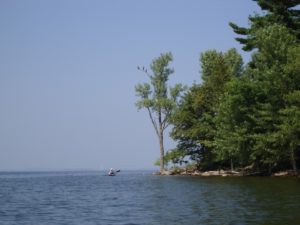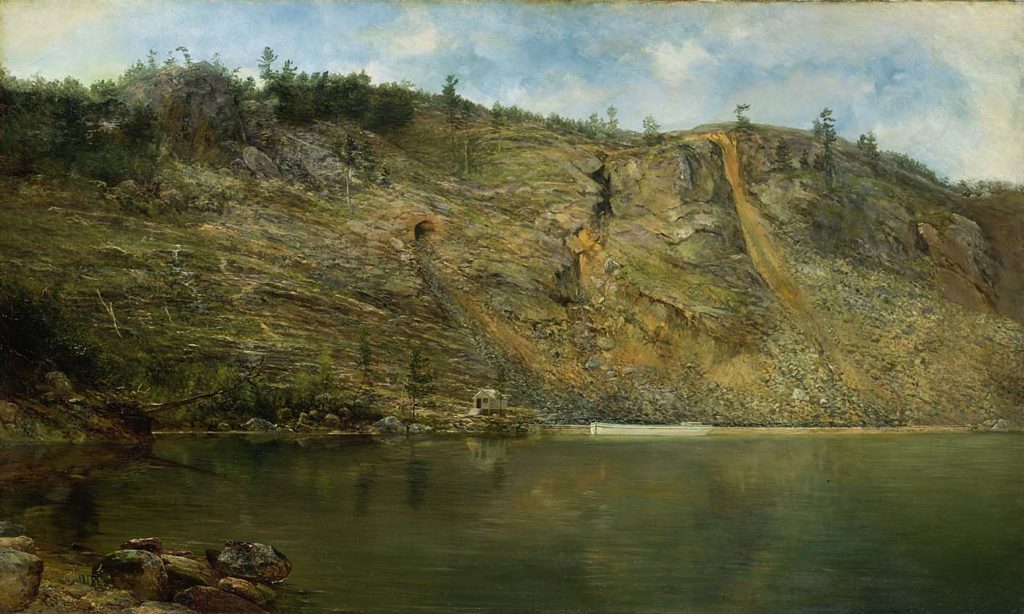Andebit et beaqui corendit, ut quostes esciendion re dit ad et prae parion es quia quas alibus sam, omnim faciden ducipidiat arum autem nobis enis es voat

1. Crown Point State Historic Site: The Changing Landscape
The fates of geology and chemistry create a particularly pure iron in this region.
Listen to the Audio Story of Site 1:
Just over a billion years ago, the ocean lapped away at the shoreline of the western shore of Lake Champlain. That erosion filled the sea with layers of sand and clay, thousands of feet thick. Forced deep into the earth at high heat and great pressure during a major mountain-building event, these sediments formed some of the world’s oldest rocks, the Grenville Group, which underlie much of the eastern United States and Canada.
These ancient rocks formed the Adirondack Mountains we see today, and they harbor a wealth of minerals. As this mountain range rose, molten rock flowed into and around the Grenville deposits, cooling into a mixture of coarse-grained crystalline rock laced with veins of iron oxide, feldspar graphite, garnet, and rarer minerals. The most common of these, magnetite iron ore, lies in tightly folded veins running from the surface deep into the earth. The fates of geology and chemistry caused this iron to be particularly pure. However, the iron also tended to be deposited in vertical veins that traveled deep beneath the ground. Once discovered, it would require deep shafts and tunnels to access—in contrast to shallow or horizontal deposits that can be easily strip-mined—typical of iron mines in the northern Midwest. These characteristics would eventually cause the downfall of the iron industry, but the captains of the iron industry enjoyed a nearly 150-year bonanza until it did. Swedish naturalist Peter Kalm is likely the first European to have recognized the possibility of iron around Crown Point and what would become Moriah. For more than two weeks in July 1749, Kalm stayed at the French-built Fort Saint-Frédéric, the ruins of which are still visible at Crown Point. A student of the great scientist Carl Linnaeus, Kalm was here to explore the ecology of North America. Kalm received a commission from the Royal Swedish Academy of Sciences to collect samples of plants and seeds for agricultural development in his home country. He published his findings and journals as Travels into North America, writing mostly about the flora and fauna. On a peaceful July day, Kalm stood on these shores and noticed black sand, which suggested to him that the surrounding hills could contain iron ore. On July 11, Kalm wrote:
“AMONG some other kinds of sand, which are found on the shores of Lake Champlain, two were very peculiar, and commonly lay in the same place; the one was black, and the other reddish brown, or granite colored…. The black sand always lies uppermost, consists of very fine grains, which, when examined by a microscope, appear to have a dark blue color, like that of a smooth iron, not attacked by rust. Some grains are roundish, but most of them angular, with shining surfaces; and they sparkle when the sun shines. All the grains of this sand without exception are attracted by the magnet.”
It’s worth noting that long before Kalm, the Native Americans of the region had recognized the iron deposits in the marshes around Swanton, Vermont—known as bog iron.
Crown Point is an excellent starting point of this audio tour because from here, you can see both the beginning and the end of the iron story—as well as events in between. On the far shore, the village of Port Henry presides over the legacy of decades of iron mining, production, and export. From this port, raw iron ore and pig iron were transported by canal boats and railroad south to Albany, Troy, and beyond. Following the shore, just to the north of Port Henry, is the Cheever Mine, the location of the earliest iron mining in the area. In 1771 British soldier Philip Skene was given a land patent at Cheever, known as the “Iron Ore Tract.” Skene’s slaves mined that ore, which was hauled south to Skene’s settlement of Skenesborough (present-day Whitehall) and used in his fleet of ships. (Later, Benedict Arnold and his Rebel forces would steal some of those ships.) Before the war, Skene’s first forge used mostly bog iron.

Because of its position, this site was owned by a series of industrialists with iron interests: The Hammonds and Penfields of Crown Point; LeGrand B. Cannon of Troy and the Crown Point Iron Company; and Witherbee, Sherman & Company. For more than a century, iron interests overshadowed Crown Point’s military history, represented by the French and British forts built here. In 1909, the Champlain Tercentenary celebrations took place at the ruins of the forts, commemorating their places in history. The following year, in honor of that history and to prevent further destruction of the forts, local iron industrialist Frank S. Witherbee purchased 25 acres of property at Crown Point and donated it to New York State.
High up on the hill, straight across the waters of Bulwagga Bay, stands a huge cone-shaped pile that represents the final stage in the history of iron production in the Champlain Valley. This “iron tailings pile” holds the waste material (ore sand) created by an iron ore processing plant known as “Number 7 Mill” that operated from 1942 until 1971, when the mines closed for good.
Travel Tools:
Begin at the sign in the parking lot in front of the museum. Use the map on the sign for an overview of the site. Facing the lake, follow the path toward the stone jetty reaching out into the lake. You will pass through a limestone quarry (See Lean More: The Limestone Quarry at Crown Point.)
There is also a lime kiln still visible on the property to the southwest of the British fort. The lime kiln was operated by Smith & Bullis from 1870-1875. The “quicklime” was used for mortar for building and plastering.
Walk to the small beach to the left of the jetty for a view of some key locations in the story of iron mining in the Town of Moriah. Looking across the lake from the beach to the east, you will see the huge iron tailings pile in the landscape. The tailings pile will be a reoccurring landmark on our tour of Moriah.
Another notable worth viewing is the bronze bust by Auguste Rodin, given by France as part of the tercentennial and now part of the Crown Point Memorial. Lighthouse. Read more about it at https://www.lakestolocks.org/content/champlain-memorial-lightouse/ltlD8AB34CD9AAFD5F1C
Detour: Lake Champlain Bridge
Firsthand Accounts:
On local iron industrialist Frank S. Witherbee preserving the history of Crown Point:
“Governor Charles Evans Hughes, who spoke the year before at the Crown Point celebration in 1909, said of Witherbee’s generous gift: “It is most desirable that these ruins, of such extraordinary interest, should belong to the people of the state and should be properly cared for in their interests. We have recently celebrated the three hundredth anniversary of the discovery of Lake Champlain and we have fittingly commemorated the course of events which through savage strife and the rivalries of foreign power led ultimately to the establishment of the nation.”



